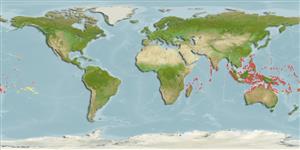>
Anguilliformes (Eels and morays) >
Muraenidae (Moray eels) > Muraeninae
Etymology: Pseudechidna: Greek, pseudes = false + Greek, echidna = viper (Ref. 45335).
More on author: Bleeker.
Issue
Genus Bohlke, pers. comm.
Environment: milieu / climate zone / depth range / distribution range
पारिस्थितिकी
समुद्री प्रवाल-भित्ति संयुक्त; गहराई सीमा 1 - 8 m (Ref. 90102). Tropical; 25°N - 22°S
Indo-Pacific: western Indian Ocean to Samoa, north to the Ryukyu Islands.
आकार / वज़न / Age
Maturity: Lm ? range ? - ? cm
Max length : 103 cm TL पुल्लिंग / अलिंग; (Ref. 9710)
पृष्ठीय रीढ़ (सम्पूर्ण) : 0; पृष्ठीय सौफट रेज़ (सम्पूर्ण) : 0; गुदा कांटा: 0; ऐनल सौफट रेज़: 0; जानवरों की रीड़ का जोड़: 201 - 214. Has a more typical muraenid head than R. quaesita.
Inhabits reef flats and shallow lagoons, usually buried in the sand or rubble (Ref. 9710, 48635). Occasionally seen swimming between its burrows in shallow protected areas (Ref. 48635). A gonochoristic species (Ref. 32169). Solitary (Ref 90102).
Life cycle and mating behavior
Maturities | पुनरुत्पत्ति | Spawnings | Egg(s) | Fecundities | लार्वा
Chen, H.-M., K.-T. Shao and C.T. Chen, 1994. A review of the muraenid eels (Family Muraenidae) from Taiwan with descriptions of twelve new records. Zool. Stud. 33(1):44-64. (Ref. 6934)
IUCN Red List Status (Ref. 130435)
Threat to humans
Harmless
Human uses
साधन
Special reports
Download XML
इंटरनेट स्रोत
Estimates based on models
Preferred temperature (Ref.
123201): 26.4 - 29.3, mean 28.5 °C (based on 2195 cells).
Phylogenetic diversity index (Ref.
82804): PD
50 = 1.0000 [Uniqueness, from 0.5 = low to 2.0 = high].
Bayesian length-weight: a=0.00050 (0.00025 - 0.00101), b=3.26 (3.10 - 3.42), in cm total length, based on LWR estimates for this (Sub)family-body shape (Ref.
93245).
Trophic level (Ref.
69278): 4.1 ±0.7 se; based on size and trophs of closest relatives
लौटाव (Ref.
120179): निम्न, न्यूनतम जनसंख्या दुगनी होने का समय 4.5 - 14 वर्ष। (Preliminary K or Fecundity.).
Fishing Vulnerability (Ref.
59153): High vulnerability (62 of 100).
